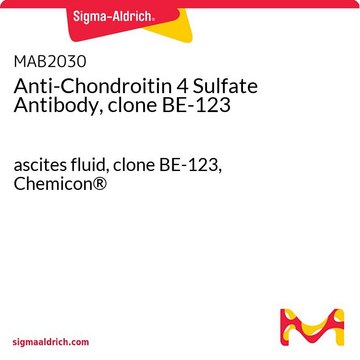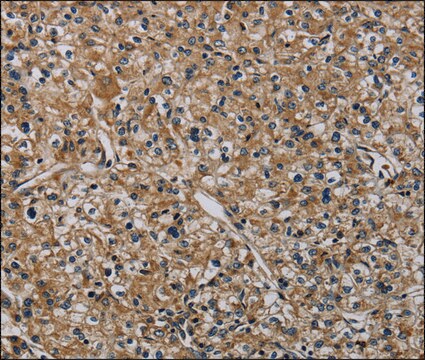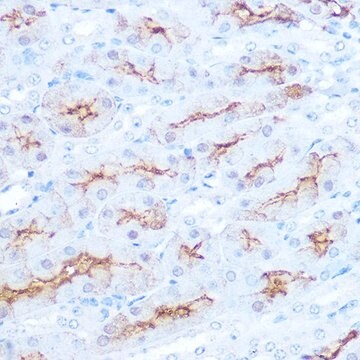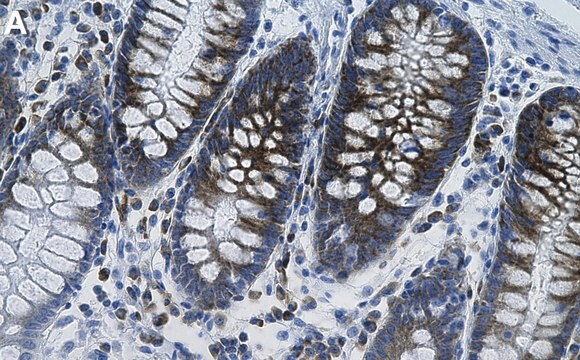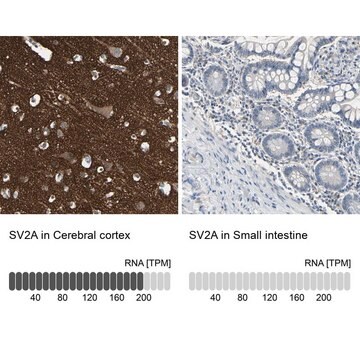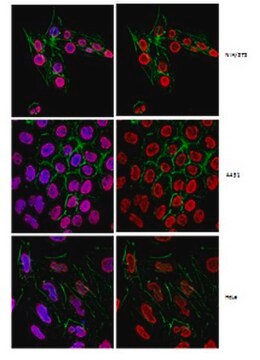General description
Legumain (UniProt: Q99538; also known as EC: 3.4.22.34, Asparaginyl endopeptidase, AEP, Protease cysteine 1, Delta Secretase) is encoded by the LGMN (also known as PRSC1) gene (Gene ID: 5641) in human. AEP is a lysosomal endopeptidase that displays strict specificity for the hydrolysis of asparaginyl bonds and can simultaneously cleave both amyloid precursor protein (APP) and tau. It cleaves aspartyl bonds slowly, especially under acidic conditions. AEP is synthesized with a signal peptide (aa 1-17) and a propeptide (aa 324-433) that are cleaved off in the mature form. It exists a homodimer before removal of the propeptide and after autocatalytic processing exists as a monomer. In its zymogen form, the uncleaved propeptide blocks access to the active site. AEP is phosphorylated on serine 226 by serine-arginine protein kinase 2 (SRPK2), which accelerates its autocatalytic cleavage and enhances its enzymatic activity. The active form translocates to cytoplasm. In Alzheimer s disease brains AEP is reported to be highly phosphorylated. Depletion of AEP is shown to reduce amyloid peptide production and senile plaque formation in 5XFAD mouse brain that leads to restoration of synaptic activity and cognitive function. Three isoforms of AEP have been described that are produced by alternative splicing. (Ref.: Wang Z-H., et al. (2017). Mol. Cell 67(5); 812-825; Zhang, Z et al (2015). Nat. Commun. 6; p. 9762).
Specificity
This rabbit polyclonal antibody specifically detects Asparaginyl endopeptidase phosphorylated on Serine 226.
Immunogen
Epitope: unknown
KLH-conjugated linear peptide corresponding to 13 amino acids surrounding phosphoserine 226 of human Asparaginyl endopeptidase (AEP).
Application
Anti-phospho AEP (Ser226), Cat. No. ABN2270, is a highly specific rabbit polyclonal antibody that targets Asparaginyl endopeptidase (AEP) and has been tested in Immunofluorescence, serine-arginine protein kinase 2 (SRPK2) Assay, and Western Blotting.
Research Category
Neuroscience
Western Blotting Analysis: A 1:2,000 dilution from a representative lot detected phospho AEP (Ser226) in lysates from HEK293 cells co-transfected mammalian GST-tagged (mGST) AEP and wild-type (WT) SRPK2. (Courtesy of Keqiang Ye, Ph.D., Professor, Emory University School of Medicine, Department of Pathology and Laboratory Medicine).
Immunofluorescence Analysis: A representative lot detected phospho AEP (Ser226) in Immunofluorescence applications (Wang, Z.H., et. al. (2017). Mol Cell. 67(5):812-825).
Kinase Assay: A representative lot detected phospho AEP (Ser226) in HEK293 cells treated with SRPK2 and in vitro kinase assays (Wang, Z.H., et. al. (2017). Mol Cell. 67(5):812-825).
Quality
Evaluated by Western Blotting in HEK293 cells co-transfected with mammalian GST-tagged (mGST) AEP and with either wild-type (WT) or kinase-dead (KD) SRPK2.
Western Blotting Analysis: A 1:500 dilution of this antibody detected phospho AEP (Ser226) in lysates from HEK293 cells co-transfected mammalian GST-tagged (mGST) AEP and wild-type (WT) SRPK2, but not in cells co-transfected with knockdown (KD) SRPK2.
Target description
~73 kDa observed; 49.41 kDa calculated. Uncharacterized bands may be observed in some lysate(s).
Physical form
Affinity Purified
Format: Purified
Purified rabbit polyclonal antibody in PBS with 0.05% sodium azide.
Storage and Stability
Stable for 1 year at 2-8°C from date of receipt.
Other Notes
Concentration: Please refer to lot specific datasheet.
Disclaimer
Unless otherwise stated in our catalog or other company documentation accompanying the product(s), our products are intended for research use only and are not to be used for any other purpose, which includes but is not limited to, unauthorized commercial uses, in vitro diagnostic uses, ex vivo or in vivo therapeutic uses or any type of consumption or application to humans or animals.


